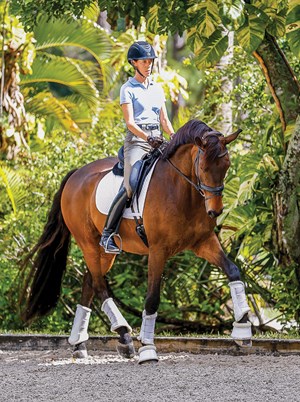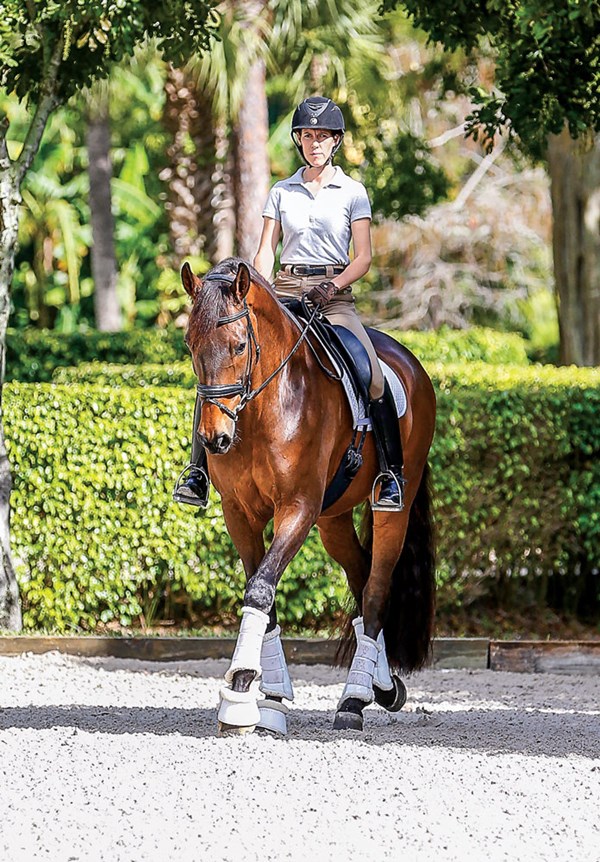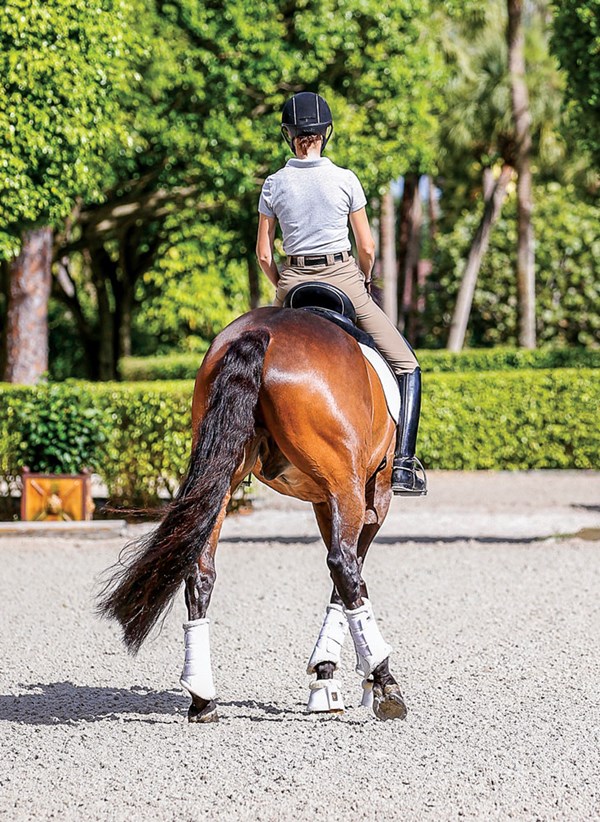
In our sport, we hear so much about the importance of the outside rein that we sometimes, even at the upper levels, get lost. It’s all too easy to forget that it’s really about both reins, and the process of getting to that ideal connection with both reins starts with the inside aids. Gaining submission with the inside aids gives us influence over the hindquarters and enables our horses to relate correctly to the outside aids.
Recently, I bought a young horse from Denmark who had never been taught how to relate to the reins. This horse got me thinking about the process of how to teach good connection. To start, there are two basic requirements of the horse:
1. He must follow the inside rein with the hindquarters. Otherwise, you basically can’t steer.
2. He must yield to the inside aids. Otherwise, you can’t put his body up to the outside aids or influence the hindquarters.
When you can establish these two things, you can create receiving outside aids. If you start with too strong an outside rein, you can end up restricting your horse or making him wobbly in his body. This is one of the things I often find myself working on with people in clinics. Now I’m finding that my new-found appreciation for the inside aids applies to the horses I ride at every level. Let’s look at these two requirements:
The rein aids influence the hindquarters. To the young horse, the inside rein needs to be able to stop him enough that he yields his hindquarters. A cowboy would call it “giving up the haunches,” which means that your horse follows the inside rein with his whole body. If you want to turn left, for example, you should be able to do it with your left rein. Your rein should relate to your horse’s hind legs in that they should follow your inside rein aid.

If your horse can’t do that, then when you take on that left rein, his head will go left but his body might keep going straight. Fundamentally, if I take the left rein, I want him to follow it and yield the haunches so his whole body turns left. And, of course, the same should happen going right. When you’re successful, you’ll feel your horse’s hips shift over as he steps under with his inside hind in an effort for the haunches to follow the track of the forehand. Ideally, he’ll straighten out and be inclined to stretch down. Be quick in that moment to reward him. This is a test, and you want to elicit that reaction. If he passes the test, then you can shorten the reins and begin your normal dressage work.
When you take that concept to the upper levels, the rein, again, relates to the hindquarters. In the pirouette, for example, my outside rein relates to the hindquarters by transferring weight back to them, but in the next instant that energy gets bounced—or mirrored—right back up to the rein and my horse wants to take me forward because energy is created in the hind legs. Now, the rein doesn’t mean “stop.” When the connection is ideal in pirouette, passage and piaffe, it fluidly enhances your horse’s gaits by creating energy and containing it in the body.
The inside aids enable the outside aids. When I teach clinics I sometimes see horses that wobble on and off the wall, which comes from the rider trying to ride straight into two reins from two legs without first establishing submission to the inside aids. You want to be able to put your horse into the outside of his body so that he stays there. When he falls in, it means that your inside aids need to be more effective. Less educated horses need to be told often: I want to place you in the outside of your body, and I want you to stay there. Then you do the same thing in the other direction: I’m going to put you in the new outside, and you’re going to stay there.

When the masters said, “Live in shoulder-fore,” they were trying to communicate this same concept. When you feel you can do shoulder-fore successfully, mix it up by riding counter shoulder-fore, or shoulder-fore left while tracking right and vice versa. My young Danish horse is still working on understanding these concepts. He’s young and exuberant and very wiggly, but after consistently explaining these simple ground rules, he is slowly getting it. The two exercises in this article help the rider establish understanding of the inside aids so the horse can be put on the outside aids.
Avoiding a Slippery Slope
Although my focus in this article has been on the importance of the inside aids, I don’t want anyone’s riding to devolve into hanging on the inside rein. The goal, of course, is that your horse goes to two reins and that you can dictate where in his body you want his balance or his weight to be. Once your horse is yielding on the inside, it creates a place for your inside seatbone, the horse takes on the shape you want and your outside rein can receive. Then you can check: Is my horse staying up in the outside aids? Yes, he is? Then change direction because you want it to be like that on both sides. Then in movements such as the shoulder-in, for example, your half halt connects you to the outside hind and then your outside aids can take on the job of regulating the tempo, the frame, the engagement and the balance. If you haven’t established the inside well enough, and you half halt on the outside, the horse’s shoulders pop in and you don’t have the ability to load the outside hind leg. When that happens, simply re-establish your horse’s yielding to the inside aids so you can put him back to the outside. When there’s no inside, there can be no outside.
When you think the connection is right, check the influence of the reins. How far back in his body does the influence of your reins go when you close your hand for a half halt? When the half halt simply compresses your horse’s neck, go back to the beginning and remind your horse with leg yield from the inside aids. When the half halt goes all the way back and adds weight to the hind end, you can affect your horse in positive, clear ways.
Safety Issues and the Inside Rein

I used to have a horse that was very spooky and one that used to stick his head in the air and leave. My coach at the time, Tina Steward, DVM, was the one who taught me the importance of the art of gaining submission to the inside rein and leg and how to apply the principles to classical dressage. I have a horse now who can bolt. With any naughty horse, I need to be able to take on an inside rein that means, Hey, stay here. Stay with me! Focus and be present. With a spooky horse, keeping the flexion to the inside means your horse won’t need to look at the scary thing and you can keep the inside hind positioned under his body. If your horse rears, you need to be able to take the inside rein and apply the inside leg to move the haunches away so he disengages his hind end and you can keep his feet moving forward and sideways in order to prevent him from going up and out of the bridle.
For horses that buck, the inside rein is helpful in that it prevents the horse from throwing himself to the inside and taking off. Use short reins and both legs. Egbert Kraak used to say to me, “Keep the head up, go forward and you’ll be fine.”
With a horse that can be naughty, don’t ride with your stirrups too long. I once got unloaded from a 4-year-old stallion because my stirrups were too long. When the horse put his head down and started bucking, I had no leverage to get my feet in front of me and get his head up.
With all of these problems, the more you can influence where the horse is in his body, the more you can avoid the feeling that your horse is able to ping his balance or his weight around. You may be riding along with your horse straight between two reins, but if he is shifting his weight around, that puts you a step behind him. It enables the horse to dive to the inside, spook or get naughty. You want more than the ability to react in the naughty moment. You want to feel the subtlety of noticing if your horse falls into your inside leg or your inside seatbone. When your horse is going to spook at something, he usually tells you: His ears go one way and he shifts his weight so that he can spin off to the inside. When you can ride those steps before the naughtiness by reacting in the moment that the ears tip, you can say, No, you need to stay here. Then you’ll be ahead of the game. And the more you can keep the balance to begin with so that he’s up in the outside of his body, the more your horse will be submissive.
Exercise 1
This is one of the first exercises I ever learned for putting my horse on the bit in walk. I was 8 years old and my instructor was Heidi Riddle. Now that I look back, establishing submission to the inside aids and guiding the horse into the receiving outside aids was an important skill!
1. Begin by tracking right from A. At K, turn straight onto the diagonal.
2. Keeping the forehand on that diagonal line, use your left leg and seatbone to turn the movement into a leg yield. You will also use a little inside rein to allow the haunches to catch up to the front end and become parallel. Now the old inside (right) aids become the new outside aids. Make sure your new outside (right) rein is allowing and receiving—not restricting or blocking.
3. As you approach the quarterline (or centerline—it doesn’t matter), slow down the front end by taking a little more with the inside (left) rein. With your inside leg and seat, bring the haunches around in a half turn on the shoulders (which is a large half turn on the forehand. I prefer to ride the “turn on the shoulder” for this exercise because in the smaller turn on the forehand, it’s too easy for the horse to bounce off the outside aids and fall in). Do this exercise slowly enough so you can allow yourself time to focus on, and be aware of where each foot is going.
4. As you finish your turn, figure out the ratio of inside and outside aids you need so that you can then go forward and leg yield back to the track at K. This exercise helps get your horse off the inside aids and put him on the outside aids. It also helps horses who like to retract their necks. The mechanics of crossing over with a hind leg shifts the pelvis in such a way that it helps the horse reach from behind toward the hand.




The Stiff and the Soft Side
Riders have a stiff side and a soft side and so do horses. Sometimes they match up and sometimes they don’t, but the sides will feel different regardless. Getting the haunches to yield is often easier on the stiff side because the horse is less collapsible in the neck on the stiff side (see photo on p. 33). However, on the soft side, the horse might just give and give and give the neck before it influences the haunches. Realize that on the soft side, you might need to take quite a bit of bend before you influence the haunches. Follow through regardless, and don’t get talked into blocking with the outside rein to make the haunches yield. Keep both seatbones on the saddle so you do not get collapsed and crooked.
Exercise 2
I learned this exercise from Canadian Olympian Christilot Boylen. You can do it in either trot or canter on a 20-meter circle. We’ll begin in trot.
1. Begin by tracking left on a 20-meter circle from B.
2. When you reach E, transition to walk and, staying on a circle line, keep a bow in the hore’s body and do a giant leg yield from the left leg into soft, receiving outside aids. This exercise, like the first one, is primarily about the inside aids. How much can you ride your horse with one side? Not that you would do this all the time, but can you do it? In the beginning, don’t be afraid to experiment and actually dump the outside rein, allowing your horse to arc onto that circle. As you progress, learn how much outside rein is the right amount.
3. Then trot forward again.
Next, try the exercise from canter, and do your downward transition to trot at E and then leg yield in trot. Ask yourself if your horse is letting you influence his inside hind up under his body. Does he stay up in your outside aids easily?



Olivia LaGoy-Weltz and Lono were the traveling alternates for the 2015 Pan American Games. Olivia has trained in Europe and is now based seasonally in Middleburg, Virginia, and Wellington, Florida, where she trains young horses to Grand Prix while running a training program dedicated to rider development (LivDressage.com).











